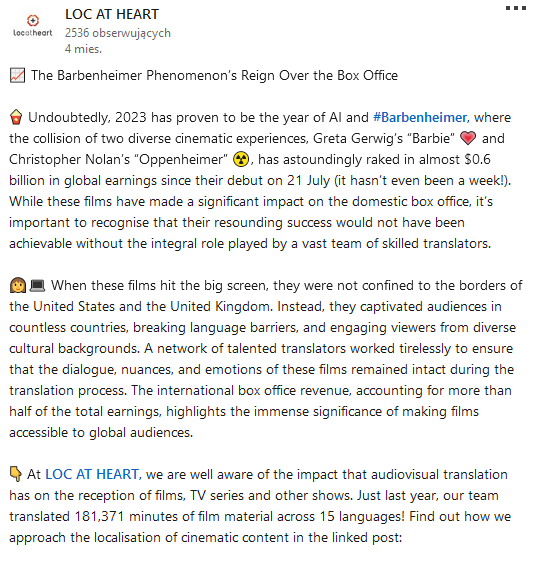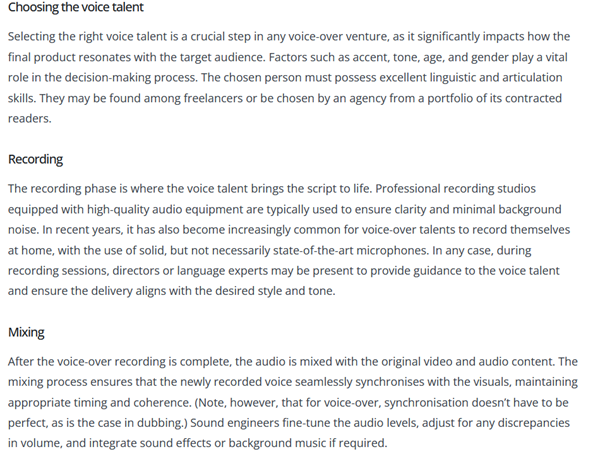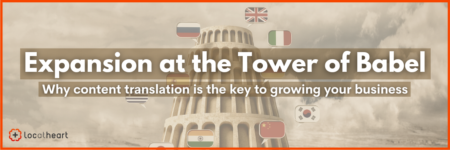Do copywriters dream of electric sheep yet? How AI transforms our processes
At our agency, we have closely followed the developments in AI and its application in the industry since at least 2019 (when the topic was approached during the Translation and Localisation Conference which we attended). However, even as we participated in a lecture on the future of AI at the 2022 Copernicon fandom convention, all speculations and theories seemed to relate to a more or less distant future.
“Artificial Intelligence is not a Man versus Machine saga; it’s in fact, Man with Machine synergy.”
– Sudipto Ghosh, author at AiThority
But while we’re typing these words in 2024, AI is not just our future – it’s already our present. It’s the here and the now.
To put it into perspective, let’s just compare the capabilities of an average, available-to-public text-to-image generator from 2022, 2023, and 2024:
2022

2023

2024

All images were created using the prompt “translator working on a translation in a medieval castle, in the style of an impressionist painting”. The old images were used in our article from January 2023.
The difference is quite striking. While image-creating AI still has numerous flaws – some of which might be insurmountable – the overall quality has much improved, as has the processing time.
And what about AI writing tools? There are already dozens of options to choose from, including free, freemium, and paid ones. Among many other things, their services encompass drafting blog posts and whole articles, proofreading texts, and ideation (suggesting topics to write about for a human author).
Since 2023, we have been applying AI tools in our everyday operations to create content for our social media and locatheart’s website. And this is only natural. For a company working in the digital landscape, the adoption of state-of-the-art technology is not just a welcome addition – it is a must. Just as years ago translation agencies widely adopted CAT tools, or began offering a whole new service called post-editing, so in the 2020s the time has come for allowing AI copywriting solutions to provide aid to both linguists and project managers.
AI text generation tools and their capabilities
Text generation models, of which the most famed example is ChatGPT, have revolutionised the realm of natural language processing. These AI copywriting tools can draft human-like text with ever- improving coherence and context-awareness, given a prompt (an order such as “generate a text summarising the plot of Titanic”).
Whether it’s writing an article, composing a poem, or even creating code, the capabilities of these models are vast and continually expanding. They understand linguistic nuances, can adapt to different styles, and even exhibit a degree of creativity. Advancements in text generation models are pushing the boundaries of what is possible with AI, opening new potentials for automation and assistance in various sectors.
As we’ve said, we have paid close attention to the developments in the AI territory. And notably, on 1 March 2023, an important online conference was hosted by Custom.MT – an AI and machine learning operations agency – which was dedicated specifically to large language models in the area of localisation (based on the example of ChatGPT). Our detailed summary of the event, which – if you’re knowledge-hungry – also links to posts about particular topics, is available here.
How AI can help copywriters
AI writing tools present a multitude of opportunities for copywriters. With the ability to draft contextually aware, coherent text in response to prompts, AI-powered tools can serve as valuable allies in several aspects of the copywriting process.
For example, they can expedite the brainstorming phase by generating a variety of potential headlines or slogans for a marketing campaign. What is more, AI tools can – in an instant – auto-generate product descriptions for e-commerce platforms, significantly reducing the manual burden. The linguistic adaptability of these tools, in theory, allows them to fit into different brands’ voices, aiding in maintaining consistency across various content pieces.
On a broader level, generative models aid in scaling content production, helping businesses reach a wider audience without automatically compromising the quality of the content. Indeed, as AI tools advance, the spectrum of possibilities they offer to copywriters is expanding, paving the way for a more efficient and creative future in the field.
How AI does help locatheart linguists
In some cases, locatheart linguists (who are native speakers of their respective languages) use generative tools. Consulting them is an option for our internal content, such as the website or social media. What is important to remember, however, is that skilful use of AI models is not limited to prompting. Even more important is the analytical mind, able to scrutinise the generated content and correct all its mistakes. From what we see on various websites that obviously use AI-generated content, it’s not such a common skill yet. But our linguists have already acquired it.
Currently, by testing the use of AI for content creation on our internal materials, we develop processes for handling such ventures. Aspects like quality assurance, pricing, and other must be meticulously hammered out so that any potential project for an actual client is carried out seamlessly.
Our present experience with AI tools suggests that while they’re tremendously useful and potentially ground-breaking, human supervision is paramount. The mechanics of generating textual content by AI models is simply too precarious to be trusted. For this reason, all our AI-aided internal content is rigorously verified by in-house linguists, who are ultimately responsible for the final text.
The following are some of the tasks which we sometimes tackle with the aid of artificial intelligence:
- coming up with ideas for, or drafting the outline of, blog posts;
- drawing up content briefs;
- occasionally, generating LinkedIn posts on a given topic (significantly edited before publishing);
- creating images to accompany the said posts (it should now be clear why we began this post with remarks about image generation AI 😊);
- researching a given subject matter for the purpose of translation or copywriting (along with looking up the topic in “traditional” sources to filter out AI hallucinations).
Once again, it must be stressed that none of our content pieces is pure AI – at the very least, and depending on the situation, proofreading is always necessary. Like other tools, AI models should serve their handler, and not the other way round.
Now, let’s see what all this looks like in practice – how an AI prompt is transformed into business content.
Case file 1. A LinkedIn post
Consider, in that order, a part of ChatGPT’s generated answer regarding the Barbenheimer phenomenon (1), and the improved LinkedIn post available in our profile (2).
1)

2)

As can be seen, the tool’s suggestion for post opening was useful, so we included it (with some adjustments).
Case file 2. A blog post
We asked the AI to suggest necessary steps for carrying out a voice-over translation project. Below are some of its tips (1, 2) and a corresponding passage from the text (3).
1)

2)

3)

AI parts were largely common-sense, factually true information. They came in handy for the copywriter who didn’t have to write everything from scratch but could work basing on AI output. What’s important, the author added parts that provided the reader with industry-specific details, which aren’t common knowledge outside the localisation market. The final post can be read here.
Case file 3. Image generation
Using the Midjourney image creation engine, we provided the following prompt for the AI (the literal title of a blog post we wished to publish with an illustration): “Multilingual SEO best practices. How to optimise your website for global visibility –aspect 16:9”. This is the resulting image:

As you can see on our blog, we used it to illustrate one of our recent posts.
Other AI tools that we have tested
In addition to the models mentioned earlier, we have considered many other options, including both premium and free AI tools:
We have started using this tool only recently, so it hasn’t yet made it to our detailed overview. Nevertheless, it already proves useful for various processes, such as LinkedIn post drafts or image generation (it offers both text and graphics services). It’s a paid option but Jasper’s data usage policy is more transparent than the free ChatGPT’s one, and it safeguards more aspects vital from a legal (copyright) point of view.
One of the generative text options tested by us, it has some interesting features, such as summarising articles from provided links; however, it’s paraphrasing skills are less impressive than Jasper’s or ChatGPT’s (as of December 2023). Also for this reason, we decided not to prolong our subscription.
This tool can be integrated with text editing tools and is advertised as an opportunity to “write like a native speaker”. It is limited to English and allows for AI-aided text revision. However, available options are rather simple and the tool requires purchasing a subscription. Still, it guarantees data safety, which is a big plus. Nevertheless, we haven’t introduced InstaText to our copywriting routine.
A free graphics generation tool with similar capabilities to Midjourney and Jasper.
All in all, we tend to employ mostly ChatGPT and Jasper, with other models occasionally consulted for particular tasks.
A welcome innovation: harnessing AI while avoiding pitfalls
In conclusion, the advent of generative AI has brought about a sea change in the landscape of localisation services. This transformative technology has the potential to redefine and elevate the endeavours of language service providers. However, the true depth and range of its abilities are yet to be fully explored.
Importantly, for the foreseeable future – and very likely beyond it – AI models’ creations must be overseen by skilled linguists who are native speakers of the languages in question. AI hallucinations and repetitiveness – despite a degree of creativity – are a sufficient reason not to trust machine texts blindly. However, human mind’s “divine spark” and AI’s gigantic work capacity can surely lead to ingenious content creation.
Update: generative video models
On 15 February 2024 – already after we prepared the above article but before its planned publication – a tool by OpenAI for creating videos based on prompts premiered. The model, named “Sora” by its creators, allows for generating high-quality films (in terms of visuals) in response to a prompt for the AI.
While similar models have existed for some time, until February of this year, due to their very low quality – and often comedic nature – they had not yet been publicly recognised as another piece in the spread of AI solutions. Up to that point, distinguishing human work from machine output was very easy.
The emergence of Sora – currently not yet available for public use – has dramatically altered this situation. Although in some places shortcomings can still be noticed, and very few parts of the clips might still evoke the uncanny valley effect, the difference of just one year of technology development is fascinating, but also quite, well, uncanny.
Could this step in artificial intelligence development seriously threaten the language service providers’ industry? While text-generating models may pose some competition especially for less skilled linguists, the emergence of a video-generating tool does not directly impact translation agencies or freelancers.
However, if we were to venture a forecast, it might go like this: with the popularisation of video generation tools, audiovisual materials requiring translation will be even more abundant than they are today. Additionally, individuals combining linguistic skills with at least basic prompting abilities will likely be highly sought after in the job market. Localisation companies and translation agencies will also need to closely monitor further developments and be able to provide their clients with the required level of service in this regard.



![Customer self-service in the digital age [featured image] - translation agency LocAtHeart](https://locatheart.com/wp-content/uploads/2021/11/1-450x231.png)


Leave a Reply